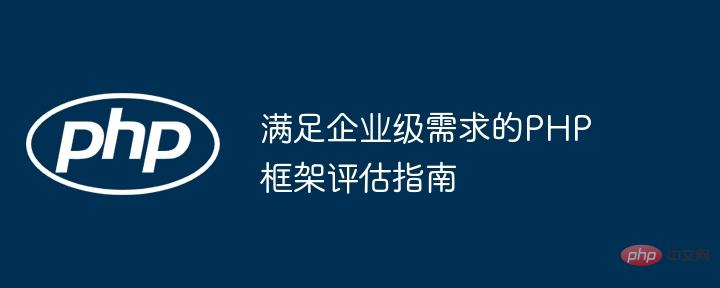 Backend Development
Backend Development
 PHP Tutorial
PHP Tutorial
 A guide to evaluating PHP frameworks for enterprise-level needs
A guide to evaluating PHP frameworks for enterprise-level needs
A guide to evaluating PHP frameworks for enterprise-level needs
Enterprises should consider the following steps when evaluating a PHP framework: Define application requirements. Research candidate frameworks based on evaluation criteria such as architecture, performance, scalability, security, documentation, and third-party support. Create prototypes to evaluate ease of use, performance, and scalability. Perform performance testing to determine load and stress capabilities. Conduct security audits to check vulnerability remediation records and industry standards compliance.

A guide to evaluating PHP frameworks that meet enterprise-level needs
Introduction
PHP Is a widely used programming language that powers dynamic web applications. As businesses seek more complex and robust solutions, it's critical to choose a PHP framework that meets your changing needs. This article provides guidance for evaluating enterprise-grade PHP frameworks, focusing on real-world use cases and providing insights into building powerful applications.
Evaluation Criteria
- Architecture: MVC, Micro Framework or Full Stack Framework.
- Performance: Application response time, throughput, and memory consumption.
- Scalability: Easily handles high loads and parallelism.
- Security: Built-in security features, compliance with industry standards and vulnerability handling.
- Documentation: Comprehensive, easy-to-follow documentation and community support.
- Third Party Support: Community extensions, libraries and plug-in availability.
Practical case
eCommerce website:
- Magento: 一A one-stop full-stack framework suitable for large and complex e-commerce stores, providing extended functionality and high scalability.
- Symfony: A powerful MVC framework for building customized e-commerce solutions with a focus on maintainability and performance.
CRM System:
- Laravel: Easy-to-use MVC framework for developing user-friendly CRM systems, Focus on rapid development and agility.
- Zend Framework: An enterprise-grade, full-stack framework optimized for high-performance and secure CRM applications.
Content Management System (CMS):
- Drupal: Flexible and modular CMS framework for building Enterprise-grade websites and applications with content lifecycle management.
- WordPress: Popular and easy-to-use CMS framework for developing small to medium-sized business websites, with an extensive plugin ecosystem.
Assessment Process
- Define Requirements: Determine your application needs such as scalability, security, Performance etc.
- Research candidate frameworks: Narrow down candidate frameworks based on evaluation criteria.
- Create a prototype: Build a prototype of a simple application to evaluate the framework's ease of use, performance, and scalability.
- Performance testing: Use benchmarking tools to perform load and stress testing on candidate frameworks.
- Security Audit: Examine the framework’s vulnerability fix record and assess its compliance with industry standards.
Conclusion
By following these evaluation criteria and real-world examples, you can gain a deeper understanding of the capabilities of an enterprise-grade PHP framework. By choosing wisely, you can choose the right framework for your application to achieve high performance, security, scalability, and maintainability.
The above is the detailed content of A guide to evaluating PHP frameworks for enterprise-level needs. For more information, please follow other related articles on the PHP Chinese website!

Hot AI Tools

Undresser.AI Undress
AI-powered app for creating realistic nude photos

AI Clothes Remover
Online AI tool for removing clothes from photos.

Undress AI Tool
Undress images for free

Clothoff.io
AI clothes remover

AI Hentai Generator
Generate AI Hentai for free.

Hot Article

Hot Tools

Notepad++7.3.1
Easy-to-use and free code editor

SublimeText3 Chinese version
Chinese version, very easy to use

Zend Studio 13.0.1
Powerful PHP integrated development environment

Dreamweaver CS6
Visual web development tools

SublimeText3 Mac version
God-level code editing software (SublimeText3)

Hot Topics
 CakePHP Project Configuration
Sep 10, 2024 pm 05:25 PM
CakePHP Project Configuration
Sep 10, 2024 pm 05:25 PM
In this chapter, we will understand the Environment Variables, General Configuration, Database Configuration and Email Configuration in CakePHP.
 PHP 8.4 Installation and Upgrade guide for Ubuntu and Debian
Dec 24, 2024 pm 04:42 PM
PHP 8.4 Installation and Upgrade guide for Ubuntu and Debian
Dec 24, 2024 pm 04:42 PM
PHP 8.4 brings several new features, security improvements, and performance improvements with healthy amounts of feature deprecations and removals. This guide explains how to install PHP 8.4 or upgrade to PHP 8.4 on Ubuntu, Debian, or their derivati
 CakePHP Date and Time
Sep 10, 2024 pm 05:27 PM
CakePHP Date and Time
Sep 10, 2024 pm 05:27 PM
To work with date and time in cakephp4, we are going to make use of the available FrozenTime class.
 CakePHP File upload
Sep 10, 2024 pm 05:27 PM
CakePHP File upload
Sep 10, 2024 pm 05:27 PM
To work on file upload we are going to use the form helper. Here, is an example for file upload.
 CakePHP Routing
Sep 10, 2024 pm 05:25 PM
CakePHP Routing
Sep 10, 2024 pm 05:25 PM
In this chapter, we are going to learn the following topics related to routing ?
 Discuss CakePHP
Sep 10, 2024 pm 05:28 PM
Discuss CakePHP
Sep 10, 2024 pm 05:28 PM
CakePHP is an open-source framework for PHP. It is intended to make developing, deploying and maintaining applications much easier. CakePHP is based on a MVC-like architecture that is both powerful and easy to grasp. Models, Views, and Controllers gu
 CakePHP Working with Database
Sep 10, 2024 pm 05:25 PM
CakePHP Working with Database
Sep 10, 2024 pm 05:25 PM
Working with database in CakePHP is very easy. We will understand the CRUD (Create, Read, Update, Delete) operations in this chapter.
 CakePHP Creating Validators
Sep 10, 2024 pm 05:26 PM
CakePHP Creating Validators
Sep 10, 2024 pm 05:26 PM
Validator can be created by adding the following two lines in the controller.





